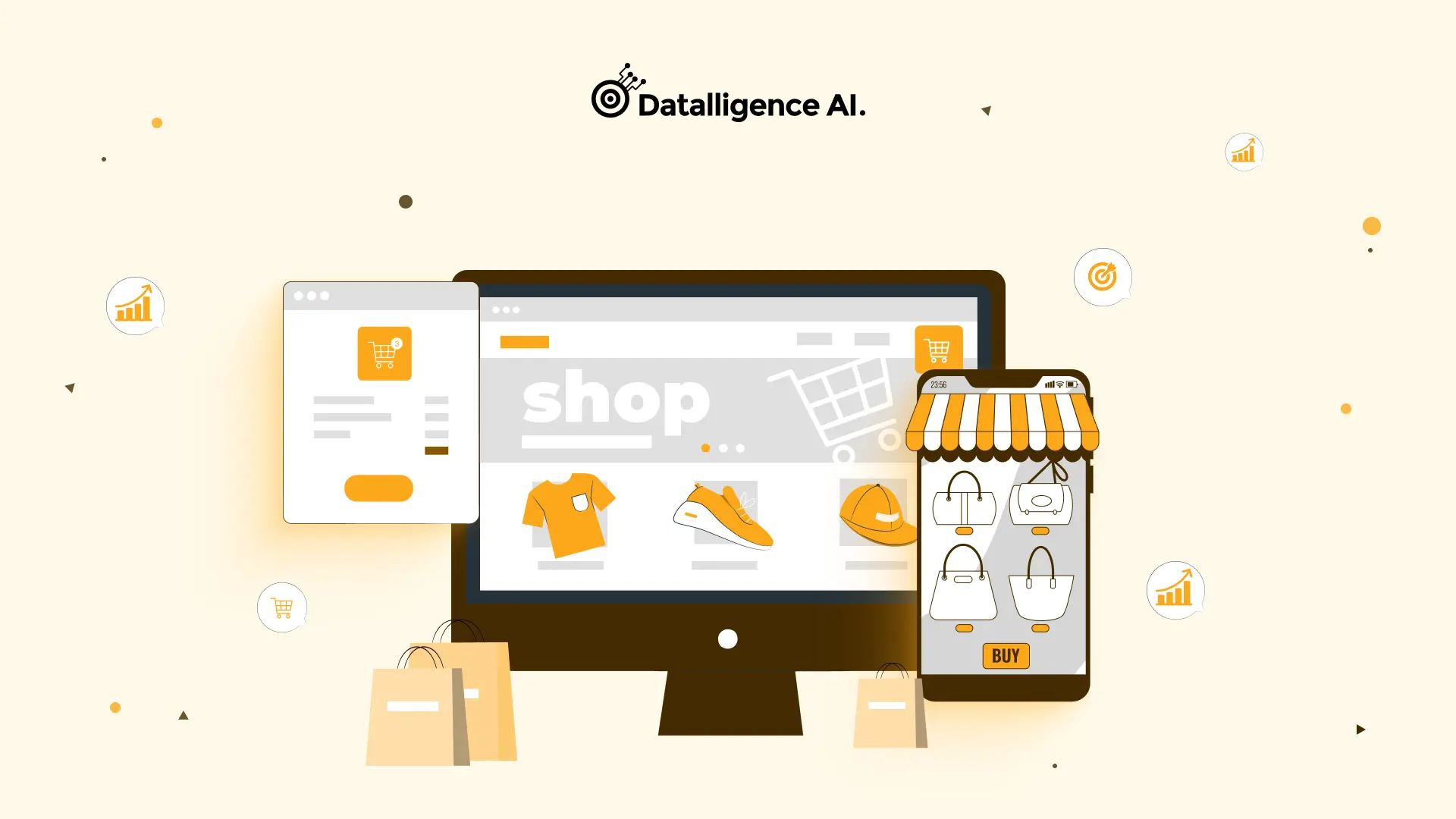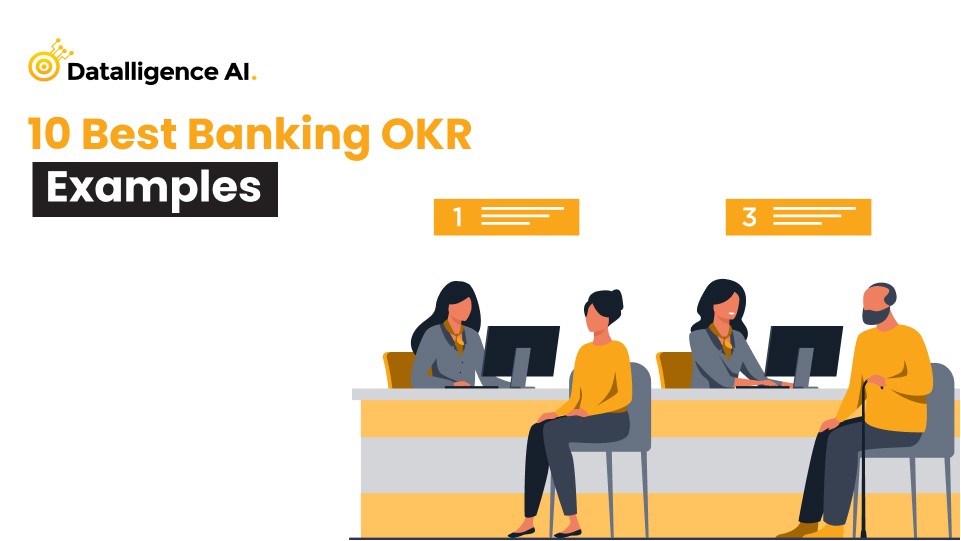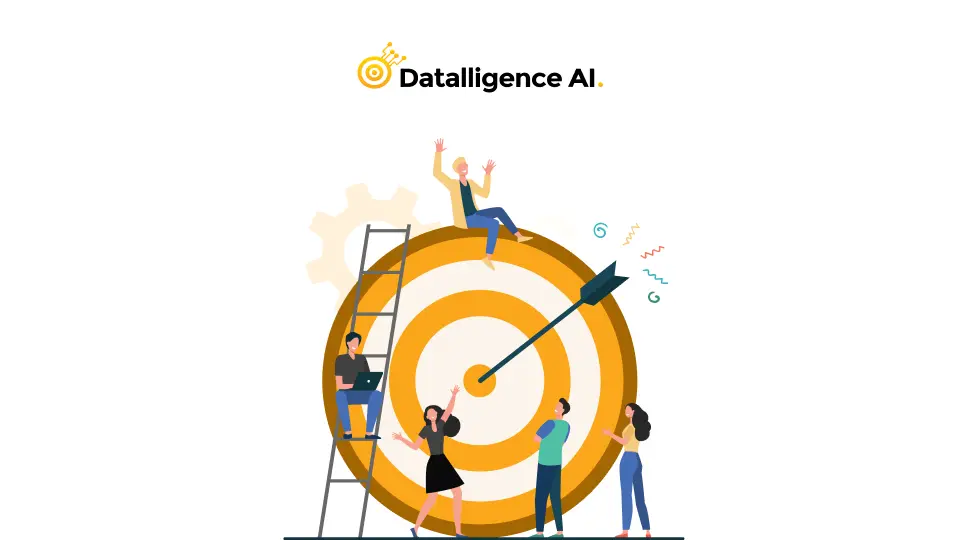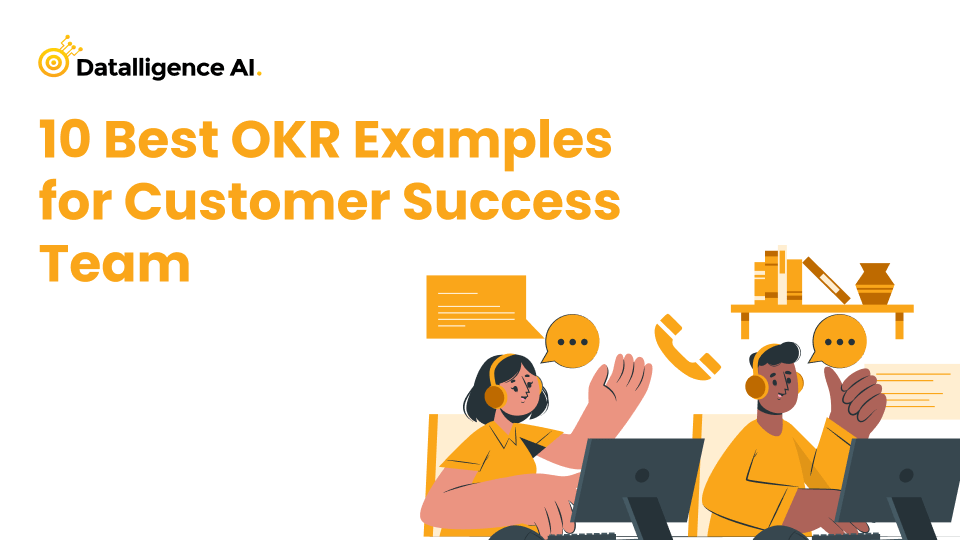In a sector as competitive as retail, it’s crucial to keep up with constant market changes, customer preferences, and technological advancements. This is where Objectives and Key Results (OKRs) come into play. OKRs can serve as a strategic compass, guiding retail businesses toward their goals, stimulating growth, and ensuring market leadership. This article presents a selection of game-changing OKR e-commerce examples that can provide valuable insights to retail companies aiming to stay ahead in the market.
Table of Contents
Navigating the Retail Landscape with OKR E-commerce
In the contemporary retail industry, companies are incessantly striving to improve customer experience, produce top-notch products, and increase sales amidst the constant demand surge. As retail businesses grapple with several internal and external challenges, the need for a clear and efficient approach to goal setting becomes paramount. Objectives and Key Results (OKRs), a robust goal-setting framework, have proven helpful for retail businesses in setting and achieving specific objectives.
OKRs consist of two components—objectives and key results. The objectives are the high-level goals that the organization or individual aims to achieve, while the key results are specific, measurable metrics used to track progress toward achieving the objectives. OKRs serve to align individual and organizational goals, ensuring everyone is working towards a common aim.
Advantages of Deploying OKRs in Retail Business
OKRs offer several benefits that can significantly enhance retail businesses’ performance. Some of these advantages include:
- Improved Concentration and Alignment: With various departments having their own set of responsibilities and objectives, retail businesses can often experience a lack of focus and alignment. OKRs help ensure that everyone’s efforts are directed towards the same objectives, keeping everyone focused and on track.
- Increased Transparency and Responsibility: OKRs enhance visibility and accountability by defining what needs to be accomplished and who is responsible for fulfilling those objectives. This ensures that everyone is aware of what is expected of them and can keep track of their progress.
- Enhanced Decision-Making: OKRs provide a clear framework for setting and tracking goals, facilitating data-driven decision-making. By aligning decisions with the company’s overall goals and monitoring progress, businesses can ensure they stay on track.
- Assists in Prioritizing and Focusing: With a multitude of goals and objectives, it can be challenging to determine where to focus. OKRs assist businesses in setting specific, measurable, and time-bound objectives, ensuring that they concentrate on the most crucial aspects.
Retail Business Examples: 10 Revolutionary OKR E-commerce Instances
The following are some transformative OKR e-commerce examples that can aid retail businesses in refining their operations, stimulating growth, and fostering innovation.
1. Streamlining Store Operations
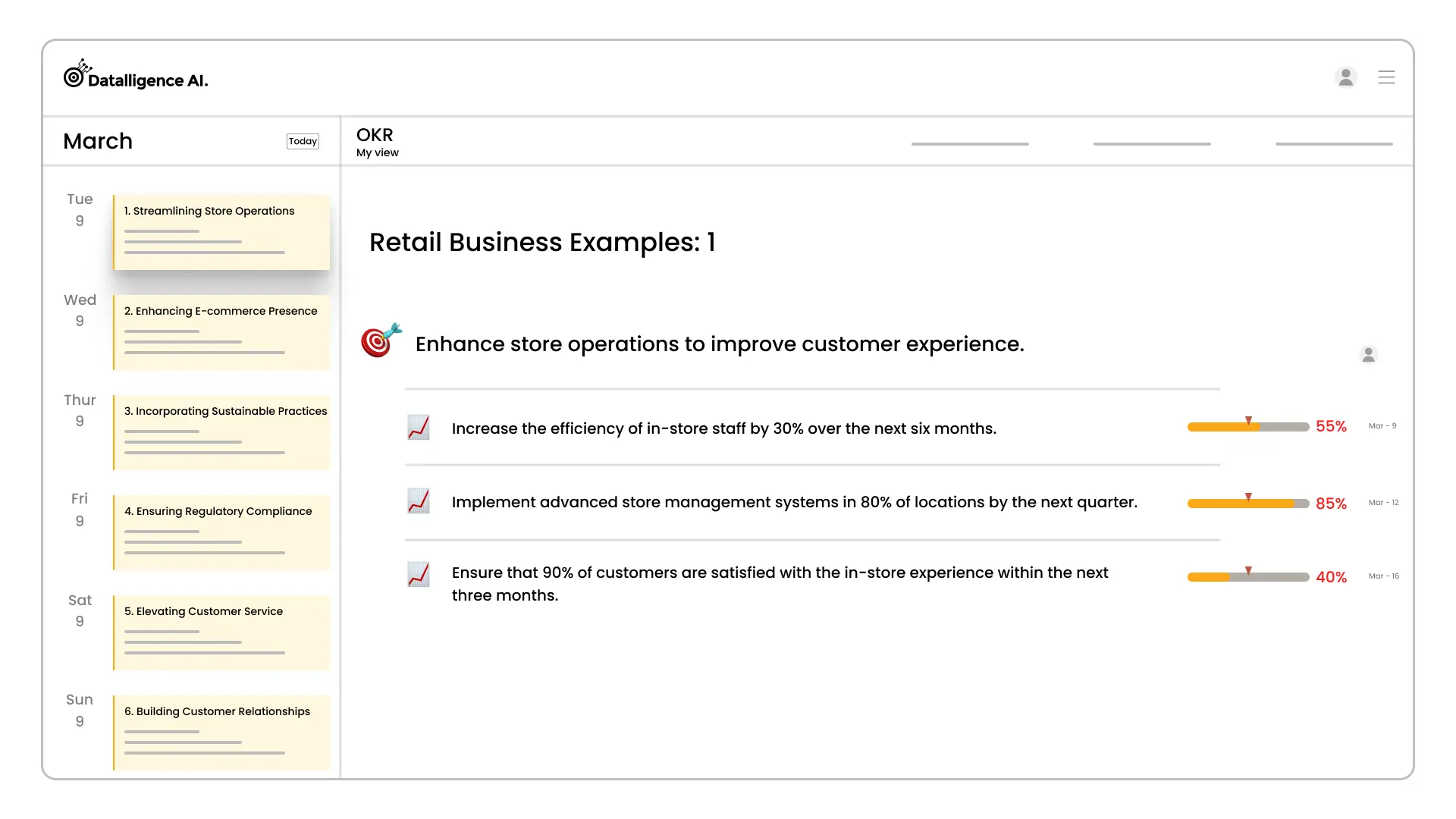
A more in-depth analysis of this OKR might involve tracking the efficiency of in-store staff by monitoring their productivity rates and customer interaction quality. Implementing advanced store management systems could involve researching and selecting suitable technologies, training staff on their use, and measuring their effectiveness post-implementation. Customer satisfaction could be measured through surveys, feedback forms, and reviews.
2. Enhancing E-commerce Presence
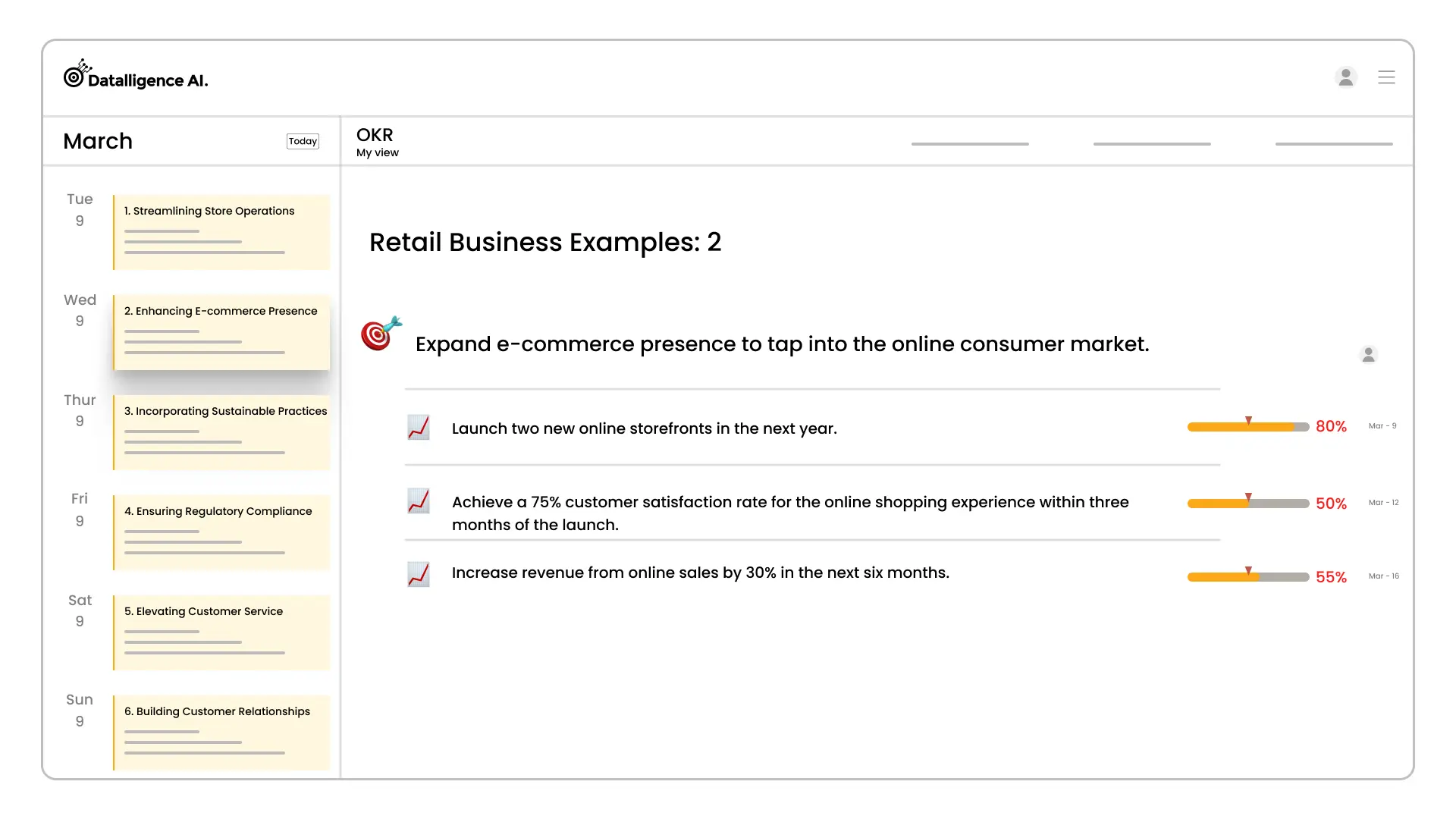
For this OKR, the focus would be on creating a robust online presence. This might involve researching suitable platforms for online storefronts, developing an engaging and user-friendly interface, and implementing effective online marketing strategies. To track customer satisfaction, businesses might consider online surveys and monitoring customer reviews. Increasing online sales revenue could involve adopting effective online marketing strategies, offering competitive pricing, and providing excellent customer service.
3. Incorporating Sustainable Practices
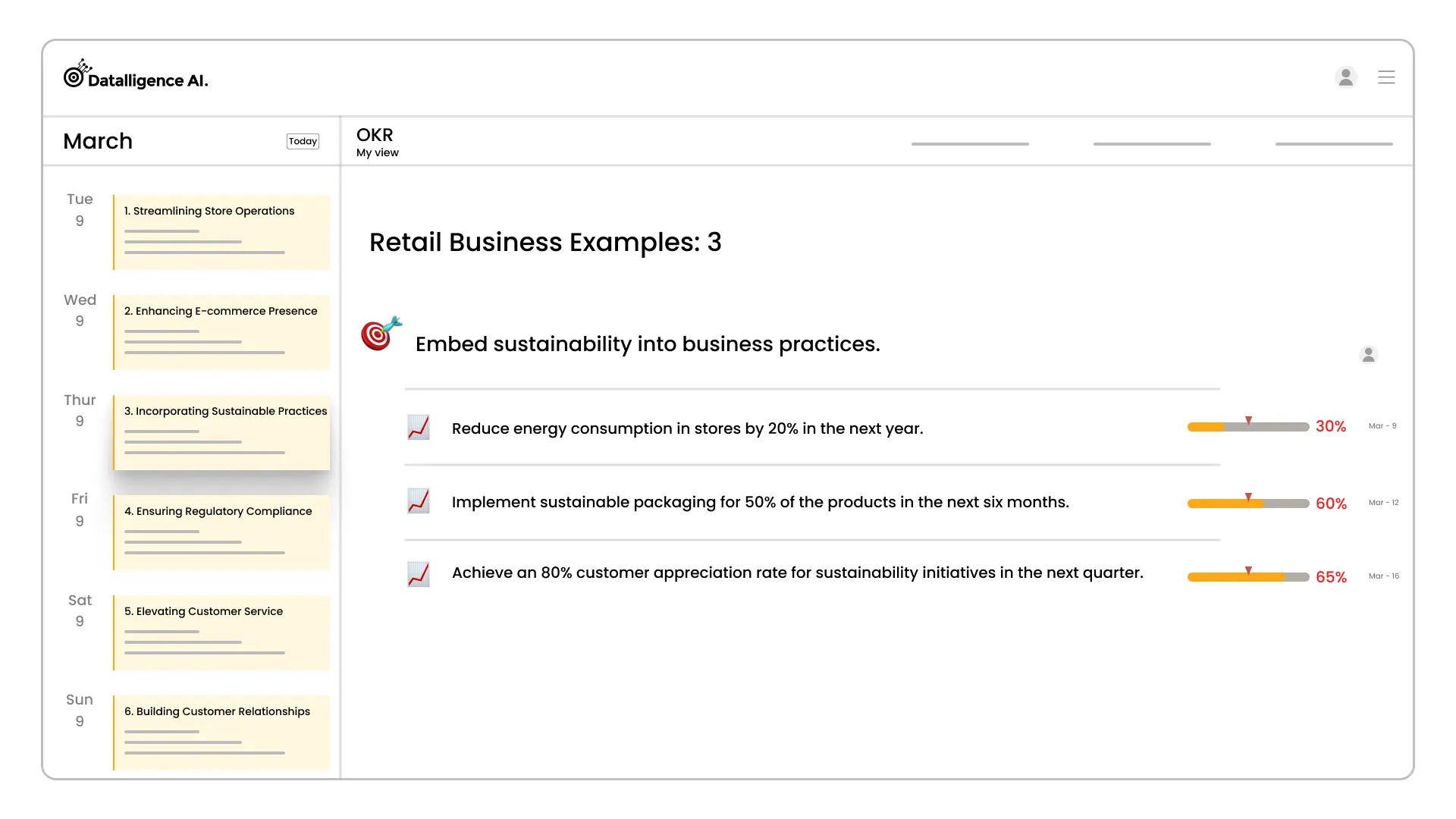
This OKR would involve tracking energy consumption in stores and identifying ways to reduce it, such as using energy-efficient lighting and appliances. Implementing sustainable packaging could involve researching and sourcing eco-friendly packaging materials and suppliers. Tracking customer appreciation for sustainability initiatives could be done through customer surveys and social media engagement.
4. Ensuring Regulatory Compliance
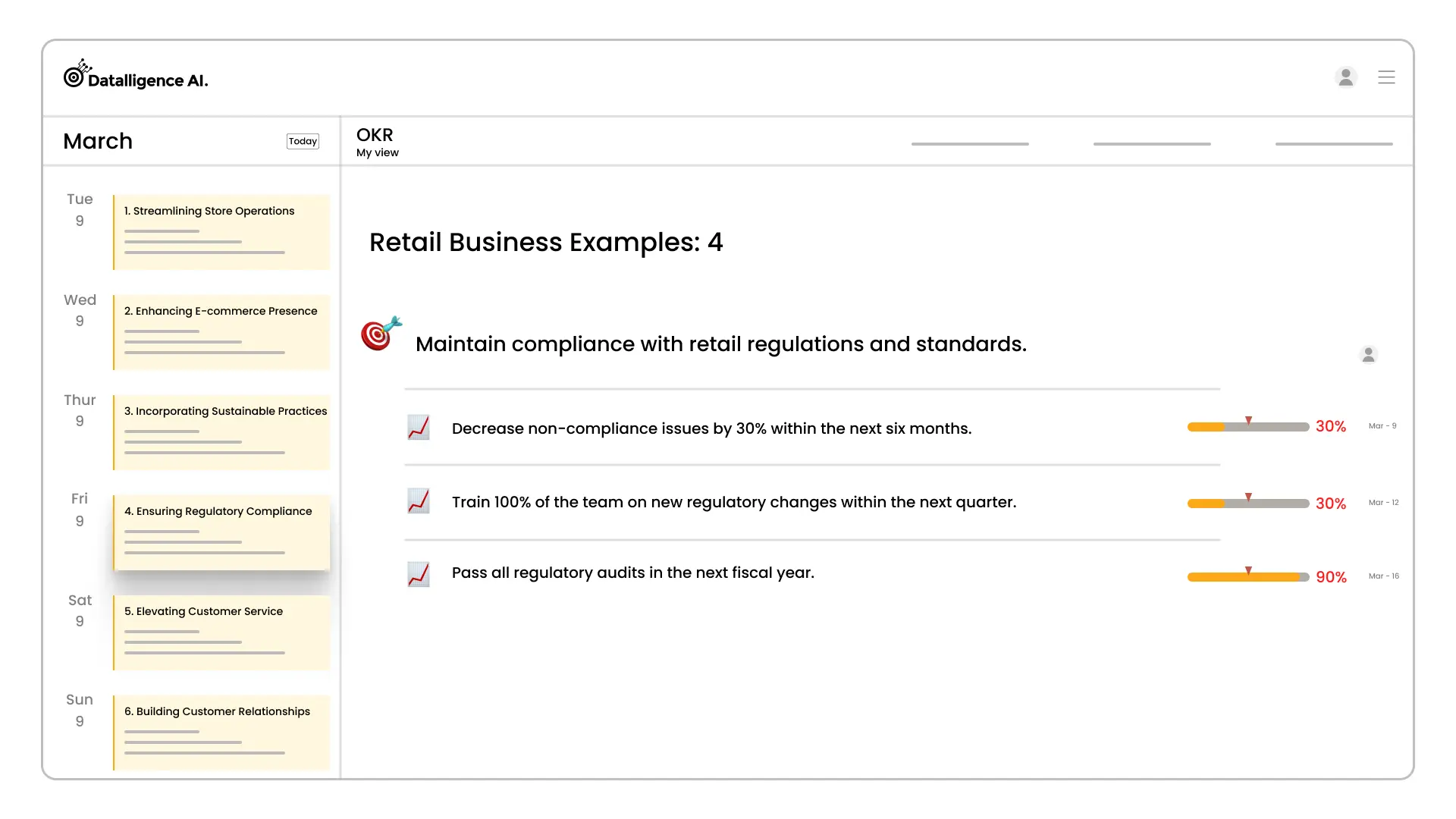
This OKR emphasises the importance of understanding and complying with retail regulations and standards. Reducing non-compliance issues could involve regular audits, training, and implementing an effective compliance management system. Training the team on new regulatory changes would involve creating and implementing a comprehensive training plan. Passing all regulatory audits would require effective compliance management and continuous improvement.
5. Elevating Customer Service
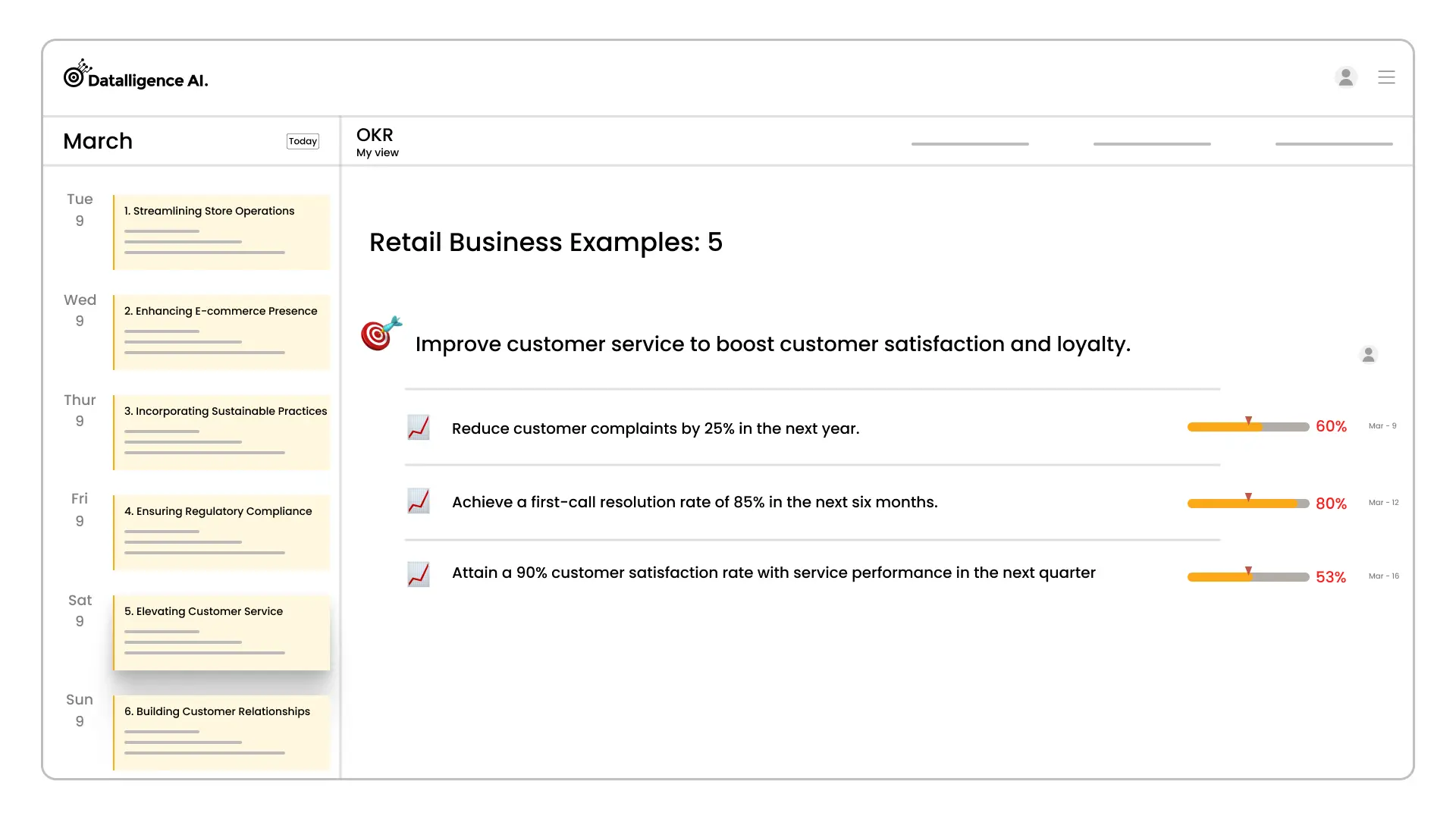
Improving customer service involves listening to customer feedback, training and motivating service staff, and implementing measures to resolve customer issues quickly and efficiently. Reducing customer complaints could involve tracking and analysing complaint patterns and taking corrective action. Achieving a high first-call resolution rate would require training and empowering customer service representatives to solve customer issues during the first interaction. Monitoring customer satisfaction rates could be done through customer surveys and feedback forms.
6. Building Customer Relationships
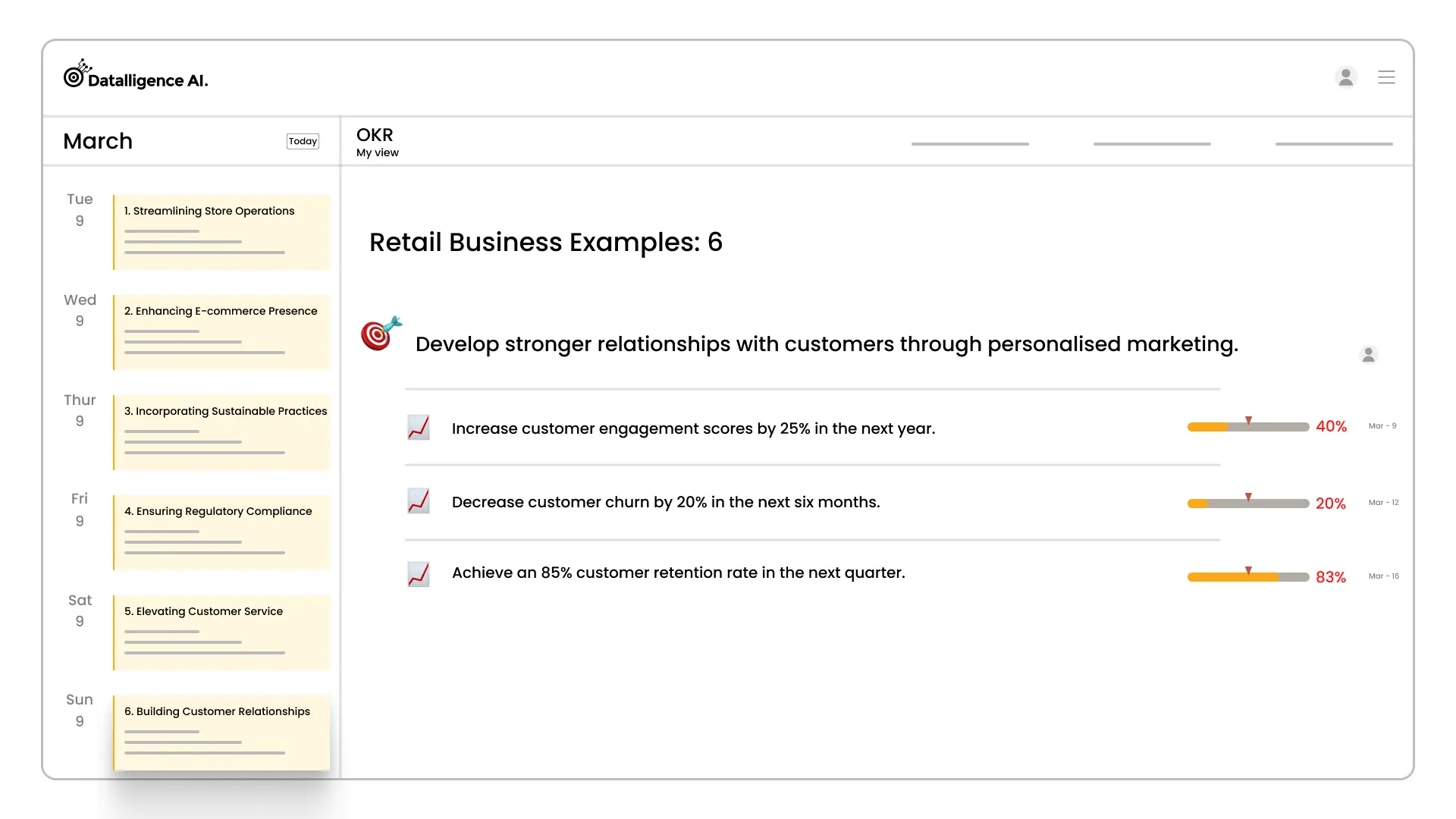
Developing stronger customer relationships involves personalising marketing efforts, understanding and meeting customer needs, and providing excellent customer service. Increasing customer engagement could involve launching engaging marketing campaigns, offering personalised recommendations, and interacting with customers on social media. Reducing customer churn could involve identifying reasons for customer churn and implementing strategies to improve customer retention, such as loyalty programs or personalised offers.
7. Expanding Market Reach
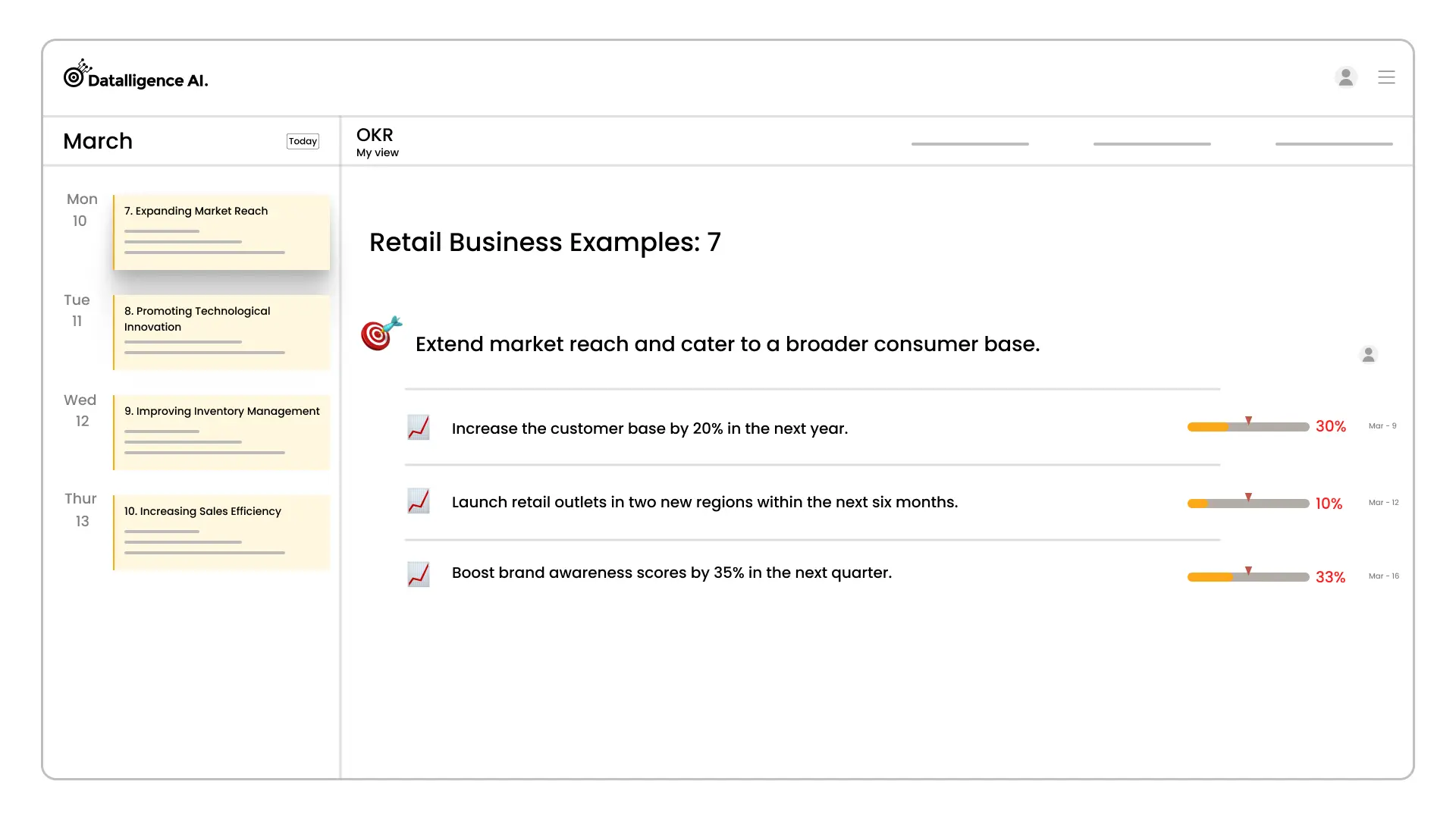
Expanding market reach could involve identifying new markets, launching marketing campaigns targeted at these markets, and measuring the increase in the customer base. Launching retail outlets in new regions would involve market research, site selection, and store setup. Boosting brand awareness could involve implementing effective marketing strategies, tracking brand recognition, and measuring the effectiveness of marketing efforts.
8. Promoting Technological Innovation
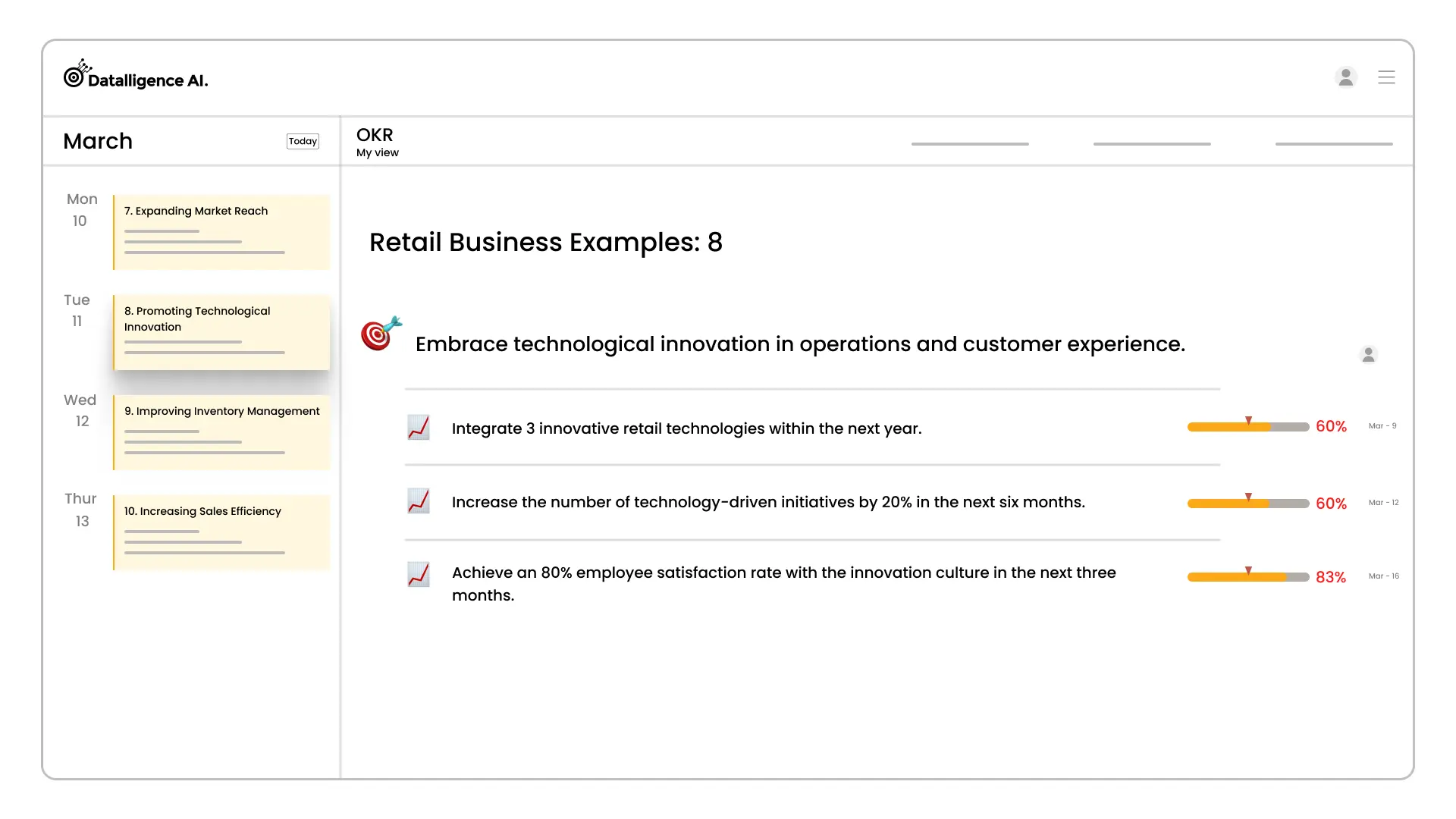
Promoting technological innovation involves staying updated with the latest technology trends in retail, integrating suitable technologies into business operations, and measuring their impact on business performance. Increasing the number of technology-driven initiatives could involve launching new projects that leverage technology to improve business operations or customer experience. Measuring employee satisfaction with the innovation culture might involve conducting employee surveys and implementing initiatives to foster a culture of innovation.
9. Improving Inventory Management
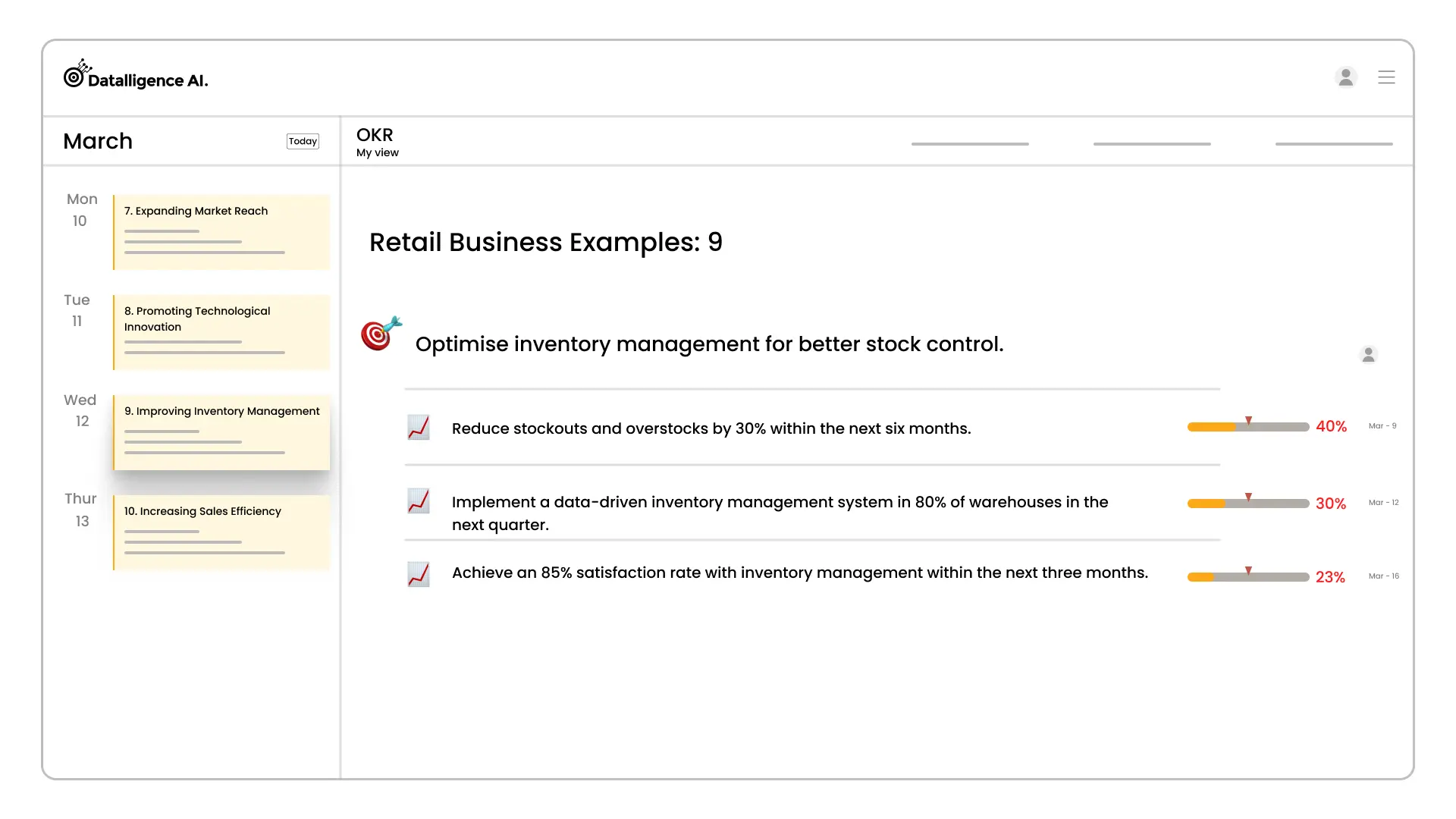
Optimising inventory management involves adopting data-driven inventory management techniques, reducing stock discrepancies, and improving stock control. Reducing stockouts and overstocks could be achieved through accurate demand forecasting, efficient replenishment processes, and regular inventory audits. Implementing a data-driven inventory management system could involve the integration of inventory management software, training staff on its use, and monitoring its effectiveness. Measuring satisfaction with inventory management could involve getting feedback from relevant stakeholders and making necessary improvements.
10. Increasing Sales Efficiency
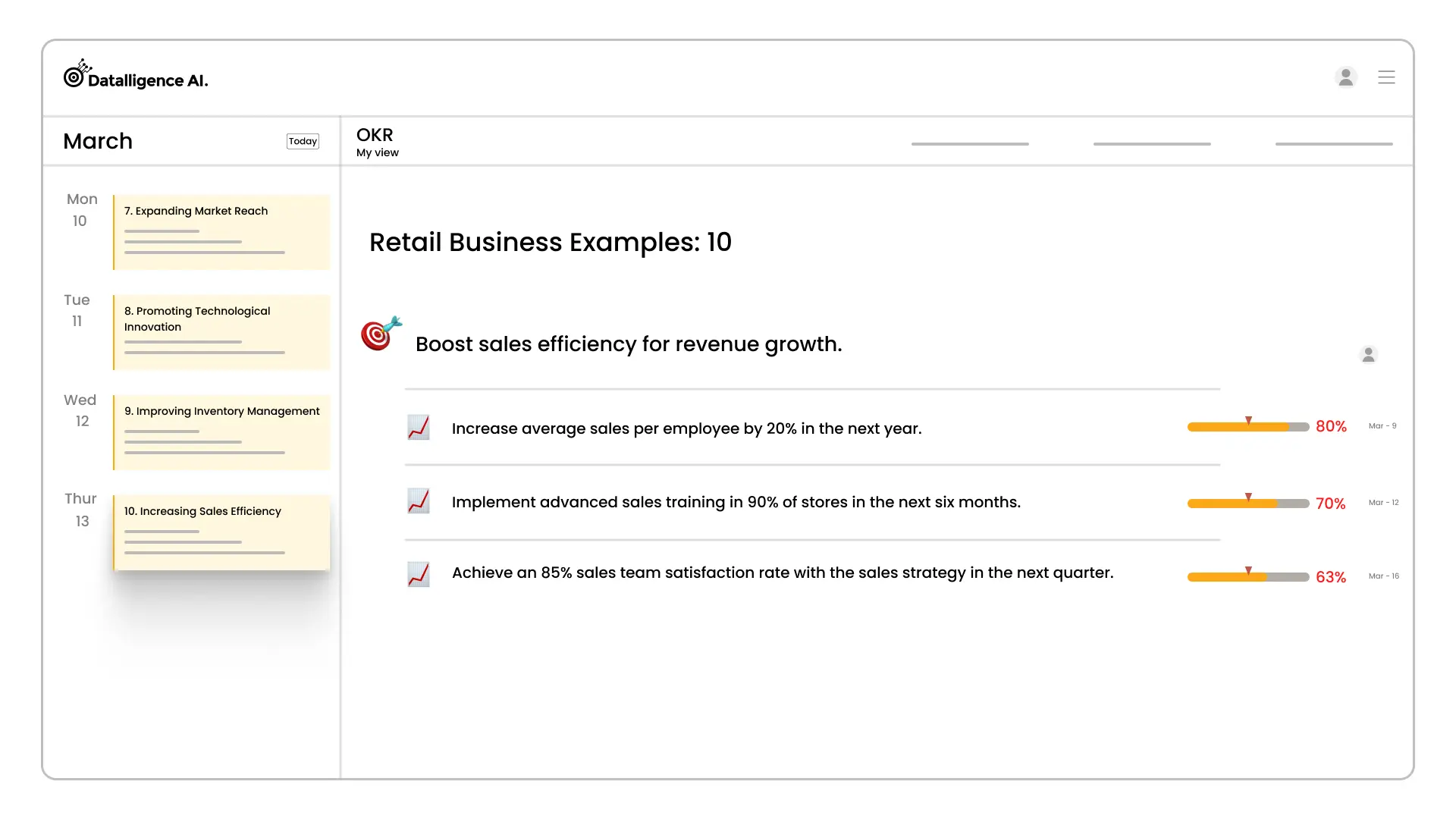
Increasing sales efficiency involves training and motivating the sales team, implementing effective sales strategies, and tracking sales performance. Increasing average sales per employee could be achieved through sales training, performance incentives, and providing the necessary tools and resources for sales success. Implementing advanced sales training would involve creating a comprehensive training program, rolling it out across stores, and monitoring its effectiveness. Measuring sales team satisfaction with the sales strategy could involve conducting team surveys and making necessary adjustments based on the feedback.
Objectives of Retail Marketing
- Increase Sales Revenue: Drive sales through effective promotions and pricing strategies.
- Enhance Brand Awareness: Increase visibility and recognition among target audiences.
- Improve Customer Engagement: Foster strong relationships and encourage repeat business.
- Drive Foot and Online Traffic: Attract customers to physical stores and online platforms.
- Optimize Customer Experience: Provide seamless and exceptional shopping journeys.
Retail Business Examples
Retail Company Examples

Frequently Asked Questions (FAQs)
1. How can OKRs drive growth in the retail sector?
OKRs can propel growth in the retail sector by setting objectives that improve operational efficiency, enhance customer satisfaction, and promote technological innovation. By monitoring key results and making necessary adjustments, retail businesses can improve their performance, meet customer expectations, and achieve sustainable growth.
2. Can OKRs help improve customer service in retail?
Yes, OKRs can play a significant role in improving customer service in retail. By setting clear objectives related to customer satisfaction and defining key results to measure progress, retail businesses can continuously monitor and enhance their customer service performance.
3. How can OKRs aid in expanding the market reach of a retail business?
OKRs can help retail businesses expand their market reach by setting objectives and key results centered around identifying new markets, launching targeted marketing campaigns, and measuring the growth in the customer base.
4. Can OKRs help in implementing sustainable practices in retail businesses?
Absolutely. OKRs can be instrumental in implementing sustainable practices in retail businesses. By defining objectives related to sustainability and tracking key results like energy consumption, use of sustainable packaging, and customer appreciation for sustainability initiatives, retail businesses can effectively embed sustainability into their operations.
Wrapping Up
In conclusion, harnessing the power of OKRs can be a game-changer for retail businesses in the e-commerce realm. By setting strategic and measurable objectives, retail businesses can streamline their operations, enhance customer satisfaction, and foster innovation. With the right OKR software, such as the one offered by Datalligence, retailers can easily set, track, and achieve their OKRs, making data-driven decisions to stay ahead of the competition.

